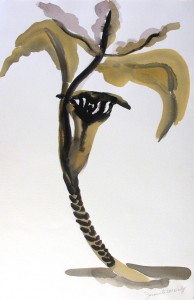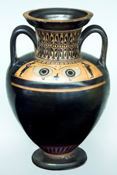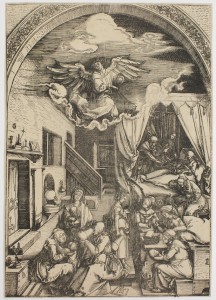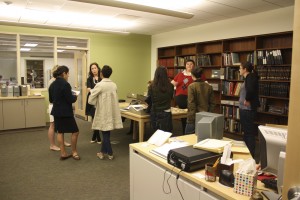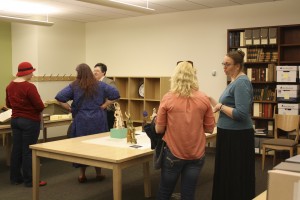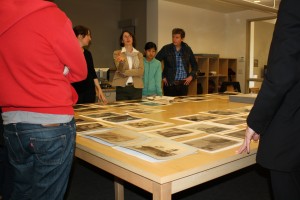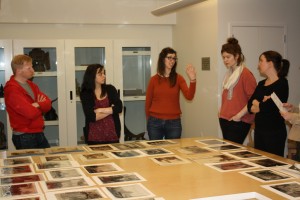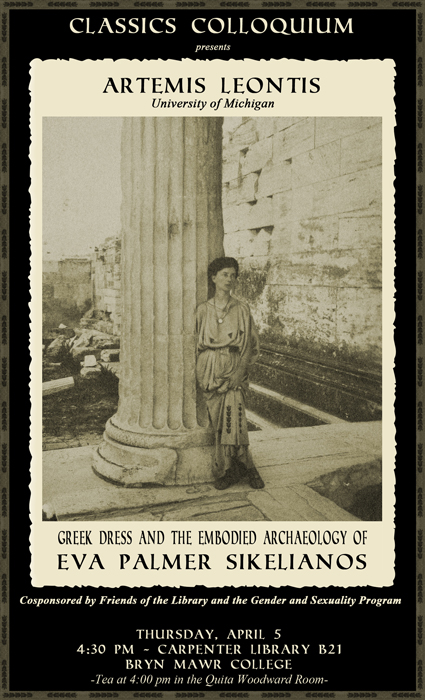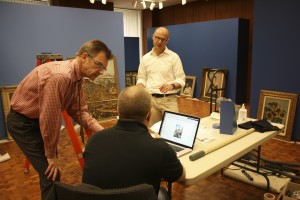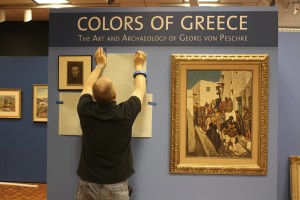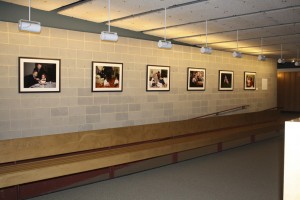Students in an Anthropology class taught by Dr. Richard Davis, recently had the opportunity of taking a class with guest instructor Anne Tiballi, PhD, Director of Archaeological Textile Studies at the California Institute for Peruvian Studies.

The students are pictured here looking at Peruvian textiles held in Special Collections at Bryn Mawr College. This included a variety of techniques, culture groups and materials from different time periods. Some of the materials displayed were from the Middle Horizon period and weaving techniques include tapestry, double cloth and brocade out of camelid and cotton fibers.
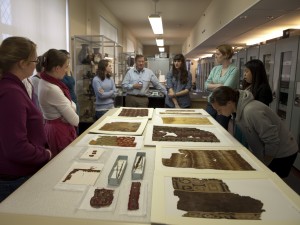
The culture groups represented included Nasca and Huari. Here are a few more close up examples of what we have in the collection….
Wari Tie-Dyed Textile Fragment with Diamond Pattern, ca. 600 – ca. 1000, Middle Horizon, Cotton fiber
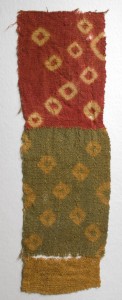 Camelid wool. Discontinuous warp and wefts joined along scaffolding
Camelid wool. Discontinuous warp and wefts joined along scaffolding
Three pieces of cloth woven together together; then taken apart for dying and put back together along header chord. Two complete pieces finished on 4 sides; yellow cloth tie dyed green or red with a pattern of diamonds. South coast, middle horizon period.
Gift of Ward M. Canaday and Mariam Coffin Canaday, Class of 1906, 2000.3.50.a
Peruvian Tapestry Fragment with Repeating Feather Pattern
 Colonial
Colonial
Cotton and camelid fiber
Very fine yarns- pattern of feathers woven, joined by very fine sewing- two sections–red background with yellow, white, and brown feathers; brown background with yellow, white, and red feathers. Brown sewn edge on one side where another section of
cloth was joined. Colonial, colors look Inca, possibly a tunic with the side binding of the tunic, feather imagery, cotton warp, excentric weft, selvedge chained off and bound differently in some areas. Spectacular piece. There are eccentric wefts making this a tapestry. The eccentric wefts contribute to the contour of the feathers. The weave density of the wefts changes. Warp and weft are camelid wool.
Gift of Ward M. Canaday and Mariam Coffin Canaday, Class of 1906, 2000.3.20.a
Peruvian Textile with Staff God and Bird Figures
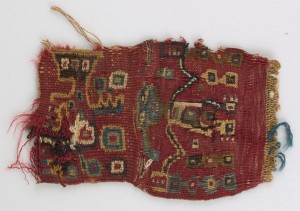 200 – 1000, Probably Middle Horizon or earlier
200 – 1000, Probably Middle Horizon or earlier
Camelid and cotton
Staff god with bird figures. Geometric patterns in white, gold, red, blue, and green camelid yarns. Cotton warp. Left side is finished, others are not.
Interlocking tapestry . Probably made as a tab to hand down from a
tunic, like a fringe. Has eccentric wefts around the eyes. Single and paired warps contribute to the compression of the fabric. Warps are cotton, wefts are wool. Made on the coast because it uses both
cotton and wool.
Gift of Ann L. Pfeiffer-Murphy, 2007.1.18
Wari (Huari) Tunic Fragment with Geometric Design and Camelid Imagery
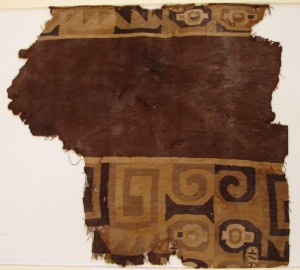 ca. 600 – ca. 1000, Middle Horizon
ca. 600 – ca. 1000, Middle Horizon
Camelid fiber
Fine geometric design in browns and golds. The design includes the eye and mouth of a Llama (or camelid) along the edges of the fragment. Remnants of red selvage binding. Very fine tapestry (high status). Wari (Huari). Wool (camelid). Dovetail tapestry joins between the colored areas. There are holes along the edge where the binding used to be, but was removed. The binding was red and yellow.
Gift of Ward M. Canaday and Mariam Coffin Canaday, Class of 1906, 2000.3.174
Peruvian Textile Fragment with Human Figure Imagery
 Cotton and camelid fiber
Cotton and camelid fiber
Slit weave tapestry fragment with three repeating alien-like figures (possibly marine animal?, possibly squid). Background is gold with figures in brown, red, and black. Sewn (lined) to balanced plain
weave blocking of brown cotton on four edges. Peruvian textile is
all wool. Lining is not Peruvian. Originally part of a belt or head
wrapping.
Gift of Ward M. Canaday and Mariam Coffin Canaday, Class of 1906
2000.3.17.a
Peruvian Knitted Ornament Depicting a Human Head
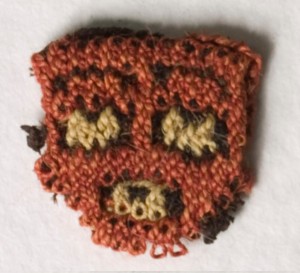 ca. 200 – 600
ca. 200 – 600
Early Intermediate, Camelid fiber
Needle knitted (Cross-knit looping) face. Fragment of fringe. Design in pink, red, brown, and white yarns.
Gift of Ward M. Canaday and Mariam Coffin Canaday, Class of 1906, 2000.3.61.a

